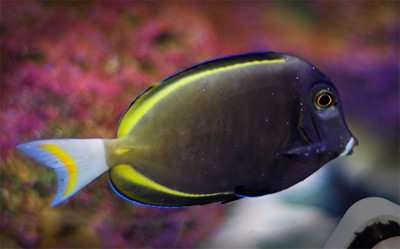During yesterday’s Thanksgiving get-together, which my wife and I host for my side of the family every year, a teenaged nephew asked me about marine ich (Cryptocaryon irritans)—the one fish disease he’s heard something about from a friend who keeps saltwater tanks. As I explained the parasite and its lifecycle and why I think it’s so important to quarantine new specimens, he asked, “If ich spreads so easily, why aren’t all the fish in the ocean infected?”
Thrilled that, for once at least, I could offer my curious young nephew something akin to wisdom, I explained that the following factors help keep ich infections at a manageable level in wild fish populations:
The vastness of the ocean
Even though coral reefs appear to be bristling with fish, the density of the fish population relative to the volume of the ocean is, if you’ll excuse the pun, a mere drop in the bucket. Remember, during the tomite, or theront, stage of the Cryptocaryon lifecycle, the free-swimming parasites must find a host fish to attach to and feed upon within a relatively short period or they die. In the vast ocean, with its limitless water volume and powerful, dynamic currents, only a very small number of tomites ever succeed in locating a host.
On the other hand, in a closed aquarium system, even if the actual number of fish specimens is fairly small, the population density is still extremely high relative to the volume of water. Of course, the density of host-seeking parasites relative to the water volume is also very high. Thus, the free-swimming tomites are virtually assured of finding a host within that brief window of opportunity.
There’s no captive-audience effect
Fish in the ocean can always swim off to greener, less “ichy” (it could be a word!) pastures. What’s more, the fish in an aquarium—even a very large system—are essentially a captive audience to this prolific parasite. In fact, some aquarium specimens never stray far from a limited niche within the system, and all tend to rest in the same spot night after night. So it’s really no surprise that if ich is present in an aquarium, the resident fish are almost sure to become infected. And if steps aren’t taken to stop the outbreak, they’ll be exposed to wave after wave of parasites and eventually perish.
Wild fish are right at home
Wild fish live under the environmental conditions and eat the foods that are most advantageous for their species and promote optimal health and vigor. As a result, even if they’re exposed to the ich parasite, they’re better poised than their captive counterparts to tolerate and survive the infection.
On the other hand, newly introduced wild-caught aquarium specimens are particularly vulnerable to ich because the rigors associated with capture and shipping, repeated acclimation to different water conditions, adjusting to a captive diet, finding their place in different tankmate hierarchies, and other stressors can significantly compromise their immune systems.



